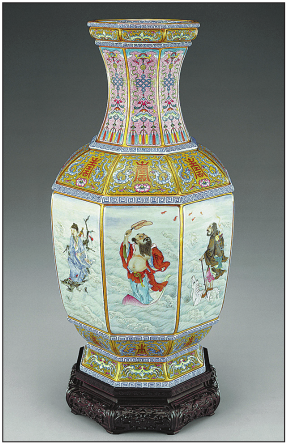
CHINA DAILY
An Ode to Dispatching Troops is seen as a model of Chinese fine calligraphy and is now on display at a retrospective exhibition The China Guardian Age at the National Museum of China.

CHINA DAILY
A famille rose vase from the Qing Dynasty is on show.
Guardian Auctions has handled many of China's valuable cultural relics over their 20 years in business. Now, a retrospective exhibition displays some of the most breathtaking pieces of China's past that have passed through their hands. Lin Qi reports.
Several decades after their split in the social chaos of the 1920s, a Sui Dynasty (AD 581-618) calligraphy work, which used to be part of the Qing Dynasty (1644-1911) court collection, has been reunited with its postscript in Beijing.
The work in its entirety is now on public display at the National Museum of China.
An Ode to Dispatching Troops (Chu Shi Song) by an anonymous writer exemplifies a distinctive calligraphic script, zhang cao, or draft cursive, only a few examples of which are still in existence today. The style provides traces of the transformation from early scripts, the clerical script (li shu) for example, to the dominating scripts of recent centuries such as running (xing shu) and cursive (cao shu) styles.
The postscript was written by Zhang Dashan, an influential scholar of the Yuan Dynasty (1271-1368), and describes his research into the content, historical background and author of An Ode to Dispatching Troops.
Seen as a model of fine calligraphy, the work's engraved version was included in the San Xi Tang Fa Tie, a court compilation of royal collections named after Qing Emperor Qianlong's study.
The work left the Forbidden City in 1922 as a reward from last emperor Pu Yi to his brother. Its main text and postscript was later separated and held in different private hands.
In 2003, the main body of the work appeared at China Guardian Auctions' spring sale, and was acquired by the Palace Museum at the price of 22 million yuan ($3.6 million).
In September, Guardian Auctions purchased 50 percent of the rights to the postscript's ownership, and together with its then owner Lu Mutao, donated the piece to the Palace Museum. Both Guardian Auctions and Lu declined to reveal the dealing price.
The display of An Ode to Dispatching Troops is the highlight of a retrospective exhibition, The China Guardian Age, celebrating the 20th anniversary of Guardian Auctions' establishment.
The Beijing-headquartered international auction house has put more than 280,000 lots under the hammer in 1,100-odd sales since its debut auction. A selection of nearly 400 paintings, antiques, sculptures, timepieces, jewelry, coins and stamps are on show as testimony to the moments of heated bidding and record-breaking sales at various auctions.
The exhibits are on loan from important collectors including the public Shanghai Museum, the private Long Museum which was founded by self-made billionaires and art collectors Liu Yiqian and Wang Wei, and Taikang Life Insurance whose chief executive officer Chen Dongsheng founded Guardian Auctions.
Chinese painting and calligraphy form a primary part of the exhibition with 204 pieces on display. Museum quality artworks include a calligraphy hand scroll by Emperor Gaozong of Song Dynasty (960-1279), an incapable ruler but a genius calligrapher.
Zhao recreated the text of Yang Sheng Lun (Discourse on Nourishing Life), an essay by Ji Kang, an author and philosopher of the third century, in both regular and cursive scripts.
"The piece is such a national treasure that when people look at it, they really want to cherish it and feel in awe of Chinese fine arts," says Guo Tong, general manager of Guardian Auctions' Chinese painting and calligraphy department.
Highlights also include Red Cliff, an ink-and-color hand scroll by Ming Dynasty (1368-1644) painter Qiu Ying, who is known for his gongbi brush technique, and a famille rose vase featuring the motif of "Eight Immortals Crossing the Sea" from the Qianlong period.
Some record-breaking works are absent from the exhibition due to the difficulty and risks in transporting them, such as Zhang Daqian's splash ink-and-color Aachensee Lake that sold for 100.8 million yuan in 2010. But visitors can appreciate quality imitations.
Besides these items that fetched mind-boggling prices, there are works that merely fetched hundreds of thousands of yuan yet exude an enduring charm.
A famille rose porcelain folding fan from the Qing Dynasty was sold for 825,000 yuan in a spring sale in 1996, and is worthy of more than one glimpse at its delicate beauty, according to Liu Yue, general manager of Guardian Auction's porcelain department.
Contact the writer at linqi@chinadaily.com.cn.
IF YOU GO
9 am-5 pm, closed on Monday, until Nov 30.
National Museum of China, 16 East Chang'an Avenue, Dongcheng district, Beijing.
010-6511-6400.
We recommend:
